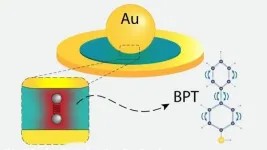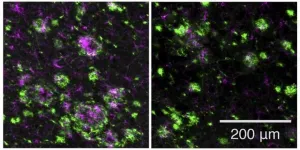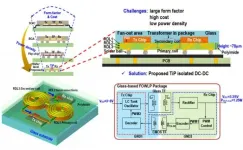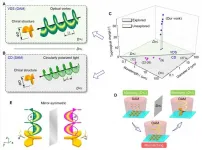Model describes interactions between light and mechanical vibration in microcavities
Study by researchers at the University of Campinas published in Physical Review Letters discusses both light dispersion by vibrations inside the device and light dissipation to the exterior, an aspect rarely studied hitherto
2021-03-02
(Press-News.org) Optomechanical microcavities are extremely small structures with diameters of less than 10 micrometers (about a tenth of a human hair) inside which light and mechanical vibrations are confined. Thanks to their small size and to efficient microfabrication techniques that enable them to hold intense light energy and interact with mechanical waves, microcavities can be used as mass and acceleration sensors and in Raman scattering (a spectroscopy technique deployed to analyze materials, including gases, liquids, and solids). A sound understanding of these phenomena can contribute in future to advances in areas such as biomedicine, including the development of sensors to detect molecules that serve as cancer markers, for example.
A study conducted at the University of Campinas’s Photonics Research Center (Photonicamp), in the state of São Paulo, Brazil, investigated a less well-known process associated with optomechanical coupling, creating a theoretical model that was validated by simulations and comparisons with experimental results recorded in the literature. The researchers report the study in an article published in Physical Review Letters.
“Two independent phenomena take place in these systems,” physicist Thiago Alegre told Agência FAPESP. “On one hand, light exerts pressure on the cavity in which it’s confined. On the other, mechanical vibrations scatter the light. Interaction between the two may occur in two different ways. If the scattered light remains inside the device, the result is called dispersive interaction. If the light escapes from the cavity, it’s known as dissipative interaction.”
Alegre is a professor at the University of Campinas’s Gleb Wataghin Institute of Physics (IFGW-UNICAMP) and a researcher with Photonicamp. He was the principal investigator for the study. The lead author of the article is André Garcia Primo, who was his PhD student at the time. FAPESP supported the study via a direct doctorate scholarship awarded to Primo, and scholarships or grants for five other projects (17/19770-1, 20/06348-2, 18/15580-6, 18/15577-5 and 18/25339-4).
Professors Newton Cesário Frateschi and Gustavo Silva Wiederhecker acted as principal investigators.
Dispersive interaction is well-understood and a basis for important advances in optomechanics, such as the LIGO interferometer that detected gravitational waves in 2016, for example, but dissipative interaction has rarely been explored in experiments. “The scarcity of experiments is due mainly to the lack of a theoretical foundation capable of accounting for the strength of dissipative interaction for a given device,” Alegre said. “Our study proposes a theoretical formulation for both dispersive and dissipative interaction.”
The proposal involves perturbation theory, which assumes that the optomechanical interaction is reasonably weak so that light and mechanical vibrations can be treated independently in an initial approximation. The description of optomechanical coupling is simplified when optical and mechanical behavior are calculated separately.
“The novelty is the way we performed the last step,” Primo said. “Essentially, contrary to what has always been done, we considered the behavior of light in the device to be physically and mathematically affected by the possibility that light can escape the cavity. When we took this into account, we realized that both the dispersive and dissipative interaction could be described with a high degree of precision.”
In the final part of the study, the researchers tested their theory by means of two experimental examples that are well-documented in the literature. In one experiment, they investigated an optomechanical cavity made of silicon and showed that both interactions, the dispersive and the dissipative, were relevant to explaining the phenomena observed. “We showed that our theory accords fully with the experiment performed and can therefore be deemed a valuable instrument to obtain devices in which these unconventional phenomena are boosted,” Alegre said.
The second example involved plasmonic optomechanical nanocavities made of gold. Nanocavities confine far smaller amounts of light than microcavities and essentially behave like nanolenses. It is possible to detect the mechanical motion of individual molecules coupled with these devices. This possibility has a wide array of applications, including the detection of chemical compounds in biological media to identify substances that can indicate pathological conditions, for example. “We showed with this theory that although it had never been reported, the dissipative scattering of light by molecules is extremely important for the optomechanical phenomena in these systems,” Primo said.
Alegre added that some of the results obtained in recent experiments and not yet fully understood are correctly described when the model produced by the study he led is taken into account.
INFORMATION:
About São Paulo Research Foundation (FAPESP)
The São Paulo Research Foundation (FAPESP) is a public institution with the mission of supporting scientific research in all fields of knowledge by awarding scholarships, fellowships and grants to investigators linked with higher education and research institutions in the State of São Paulo, Brazil. FAPESP is aware that the very best research can only be done by working with the best researchers internationally. Therefore, it has established partnerships with funding agencies, higher education, private companies, and research organizations in other countries known for the quality of their research and has been encouraging scientists funded by its grants to further develop their international collaboration. You can learn more about FAPESP at http://www.fapesp.br/en and visit FAPESP news agency at http://www.agencia.fapesp.br/en to keep updated with the latest scientific breakthroughs FAPESP helps achieve through its many programs, awards and research centers. You may also subscribe to FAPESP news agency at http://agencia.fapesp.br/subscribe.
[Attachments] See images for this press release:

ELSE PRESS RELEASES FROM THIS DATE:
2021-03-02
The study gives the first detailed description of a volcanic eruption from Sierra Negra found on Isla Isabela - the largest of the Galápagos Islands and home to nearly 2,000 people.
The findings, published in Nature Communications, reveal how the volcano inflated and fractured before it erupted and captures a new level of detail for any eruption from a volcano on the islands.
Networks of ground-based seismic and GPS monitoring stations, and satellites, captured data for 13 years before Sierra Negra's eruption, in June 2018.
The surface of the volcano rose during this time, indicating a gradual accumulation of molten rock - known as magma - found in a reservoir under the ...
2021-03-02
Ithaca, NY--The message about the bird-conservation benefits of shade-grown coffee may not be getting through to the people most likely to respond--birdwatchers. A team of researchers from the Cornell Lab of Ornithology and Virginia Tech surveyed birdwatchers to learn if they drank shade-grown coffee and, if not, why not. Their findings were published today in the journal People and Nature.
"One of the most significant constraints to purchasing bird-friendly coffee among those surveyed was a lack of awareness," said Alicia Williams, lead author and former research assistant at the Cornell Lab and Virginia Tech. "I was surprised to see that only 9 percent of those surveyed purchased bird-friendly ...
2021-03-02
CHAMPAIGN, Ill. -- The liver has a rare superpower among body organs - the ability to regenerate, even if 70% of its mass is removed. It also keeps up its metabolic and toxin-removing work during the process of regeneration, thanks to a subset of cells that expand their workload while the rest focus on multiplication, a new study in mice found.
Furthermore, the cells of the liver communicate with each other to coordinate regeneration activity, which progresses from the center to the periphery of the missing liver lobes, researchers at the University of Illinois Urbana-Champaign said.
"It's remarkable how we still don't understand many aspects of liver regeneration," said Illinois biochemistry professor Auinash ...
2021-03-02
Researchers at the University of California San Diego School of Medicine and Massachusetts General Hospital have identified a new drug that could prevent Alzheimer's disease by modulating, rather than inhibiting, a key enzyme involved in forming amyloid plaques in the brain. The study, which will be published March 2 in the Journal of Experimental Medicine (JEM), demonstrates that the drug is safe and effective in rodents and monkeys, paving the way for future clinical trials in humans.
A key pathological hallmark of Alzheimer's disease involves the formation of amyloid plaques composed of small protein fragments known as amyloid-β (Aβ) peptides. These peptides are generated ...
2021-03-02
OAK BROOK, Ill. - Attendance at regular mammography screening substantially reduces the risk of dying from breast cancer, according to a large study of over half a million women, published in the journal Radiology. Researchers said women who skip even one scheduled mammography screening before a breast cancer diagnosis face a significantly higher risk of dying from the cancer.
Breast cancer screening with mammography has helped reduce disease-related deaths by enabling detection of cancer at earlier, more treatable stages. Despite mammography's well-established ...
2021-03-02
Recently, research group led by Professor CHENG Lin from School of Microelectronics, University of science and technology of China has made significant achievements in the field of fully integrated isolated power chip design. They proposed a chip based on glass fan-out wafer-level package (FOWLP), achieving 46.5% peak transformation efficiency and 50mW/mm2 power density.
Compared with the traditional isolated power supply chip, this new design interconnects the receiving and transmitting chips through the micro transformer made of the rewiring layer, showing no need of additional transformer chips. In this way, it lowered the need ...
2021-03-02
The pandemic has impacted significantly on people who suffer chronic pain. A study performed by the eHealth Lab, a research group affiliated with the Faculty of Health Sciences and the Universitat Oberta de Catalunya's eHealth Center, has shown that 70% of the people with chronic pain have seen their condition worsen in terms of severity, frequency of episodes and interference in their daily activities.
A total of 502 patients took part in the study; 88% were women aged between 30 and 59, with long-duration chronic pain (mean duration, 7 years). Most participants (87.6%) had pain in more than one point; the most frequent locations were the abdomen, lower back and neck. The participants answered online surveys, designed in accordance with ...
2021-03-02
Organometallic reagents are essential tools in synthetic chemistry. They work even better and more effectively in combination with alkali alkoxides. The exact nature of this effect has never been well understood. A team based in Switzerland has now performed a detailed study of the mechanism of reaction of aryl bromides with organo-magnesium reagents and lithium alkoxides. As reported in the journal Angewandte Chemie, a complex equilibrium of bimetallic intermediates plays a key role.
Substituted aromatic ring systems are an important class of building block for the synthesis of many products, including pharmaceuticals, agrochemicals, and ...
2021-03-02
Recently, the Laboratory of Micro and Nano Engineering, School of Engineering Science, University of Science and Technology of China (USTC) has made important progress in the field of structural chirality detection research using vortex light and found that photon orbital angular momentum can efficiently detect the optical chiral signal of structures.
The achievement was published in an international well-known journal PNAS.
Chiral structures are widely found in nature, such as DNA double helix structures, plant tendrils and shells. In addition to observing the geometry of objects, their chirality can also be distinguished by the interaction of light with matter. For example, the detection of circular ...
2021-03-02
Aqueous free-radical precipitation polymerization is one of the most useful methods to prepare the uniformly sized hydrogel microspheres (microgels), and an understanding of the polymerization mechanism is crucial to control the structure or physicochemical properties of microgels. However, the details of the mechanism of precipitation polymerization remain unclear.
Thus, first author Yuichiro Nishizawa, Prof. Daisuke Suzuki of the Graduate School of Textile Science & Technology, Shinshu University and Prof. Takayuki Uchihashi of Nagoya University set out to clarify the formation mechanism of microgels during precipitation polymerization by evaluating structural evolution and thermoresponsiveness of developing microgels during ...
LAST 30 PRESS RELEASES:
[Press-News.org] Model describes interactions between light and mechanical vibration in microcavities
Study by researchers at the University of Campinas published in Physical Review Letters discusses both light dispersion by vibrations inside the device and light dissipation to the exterior, an aspect rarely studied hitherto





